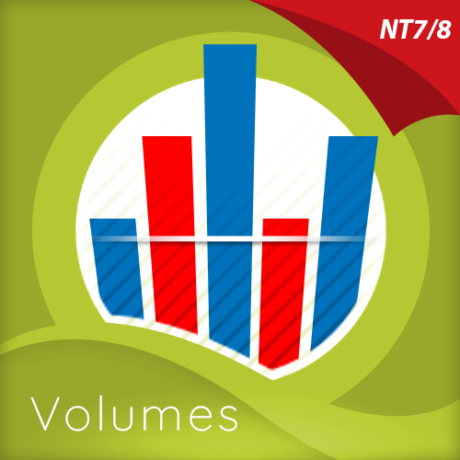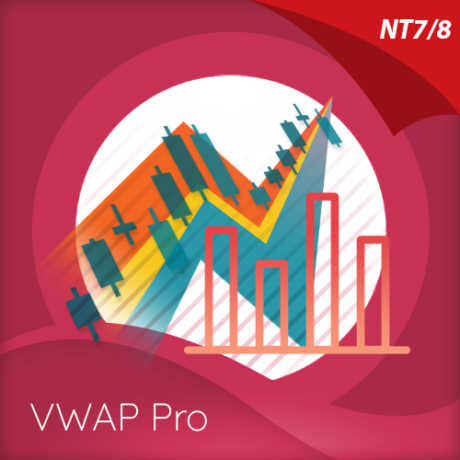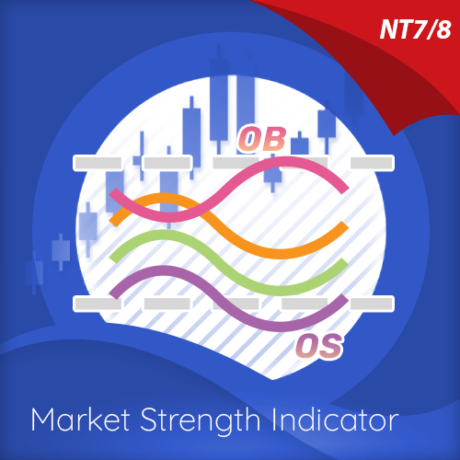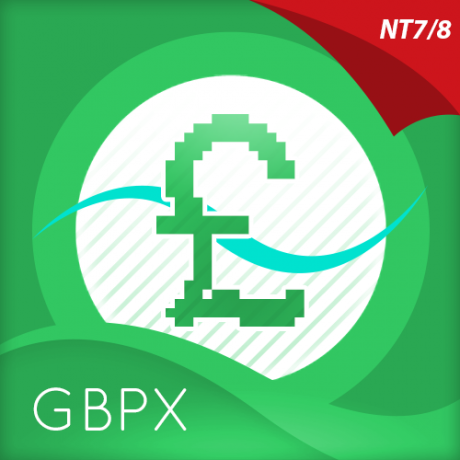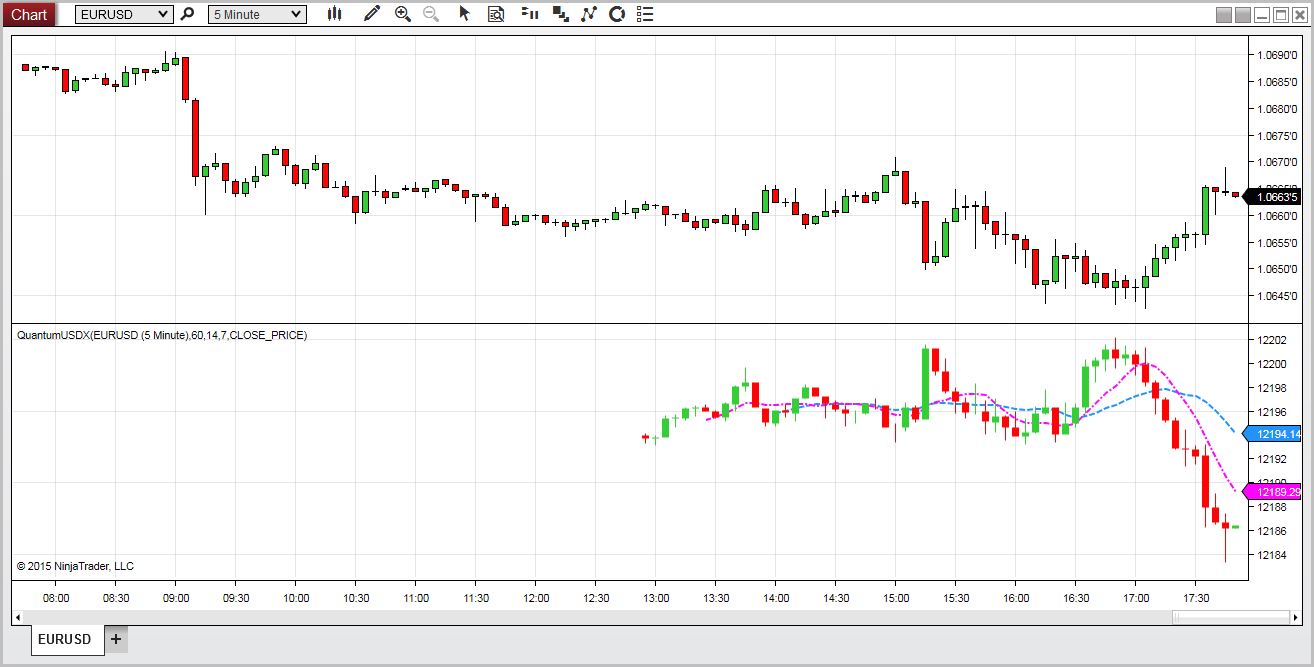
General – getting started
The Quantum USDX has been created to provide a more “balanced” view of the US dollar, more representative if you like of the world today. It has a basket of four currencies which are equally weighted, in the same way as with the Quantum JPYX indicator. These are as follows:
- Euro
- British Pound
- Japanese Yen
- Australian dollar
The Quantum USDX indicator displays strength and weakness in the US dollar against this basket of currencies. It can be applied to any chart in any timeframe, and will give you an instant view of the US dollar. Alternatively, why not create a separate workspace with multiple timeframes. Observing the movement of the USDX is essential, as it provides an alternative view of price action in related markets such as gold, oil, and agricultural commodities.
The indicator can be used in one of three ways:
- First, as an inverse indicator to a major currency pair, helping you get in, stay in, and get out
- Second as a confirming indicator for the Quantum Currency Strength Indicator, providing a perspective against other currencies
- Finally, as the ultimate barometer of risk as a safe haven currency as the currency of first reserve
Whichever approach you adopt you will no longer have to leave your NinjaTrader platform for a view of the US dollar! How cool is that!
Installation
Open your NinjaTrader platform and select a chart. We recommend that you choose a fast loading chart such as a spot currency major.
Right click the chart to bring up a menu which looks like the following image:
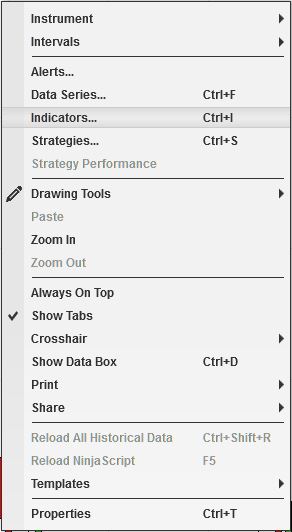
Select Indicators… which will open the following window. (Alternatively, you can open this window by clicking the Indicators button in the chart toolbar or by pressing Ctrl + I while focused on the chart.)
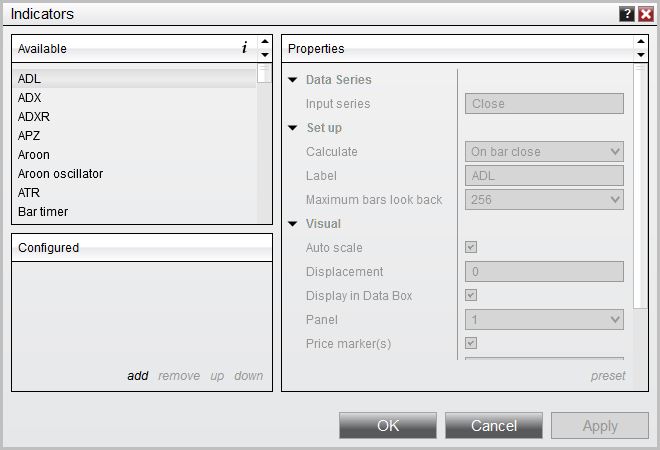
In the Indicators window, scroll down to the QuantumUSDX indicator and click it to select the indicator. Once selected, click add in the Configured frame which will put it on the list of active indicators to be added in the chart.
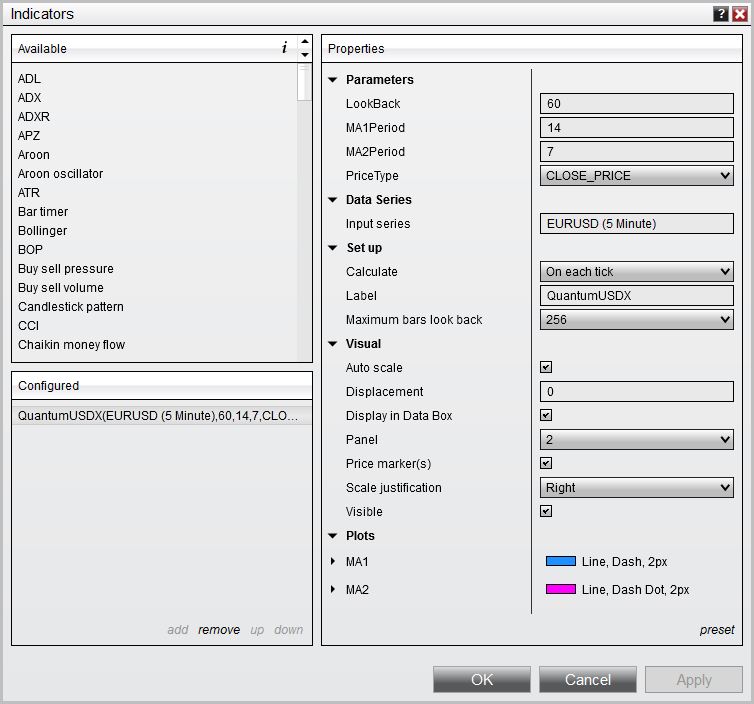
Before clicking the OK or Apply button to complete, the indicator can be configured in several different ways to suit your own personal preferences and trading style. You can click the Apply button at any time, and this will apply any changes you have made to the indicator, without closing the window. This will allow you to see the changes you have made, and to modify again before closing with the OK button, or the Cancel button.
Limitations
Due to the way data is delivered to the platform, the Quantum USDX indicator is limited to work only in time data series charts namely:
- Second,
- Minute,
- Day,
- Week,
- Month, and
- Year
If for some reason you attach the indicator to a chart other than the above data series, the indicator window will appear blank with a message at the bottom right hand corner as shown below:

Simply revert back to any of the supported data series mentioned in the message to restore output.
Configuration
All of the user configuration is found on the right hand side of the Indicator window. These are the default setting when you first install the indicator to a chart.
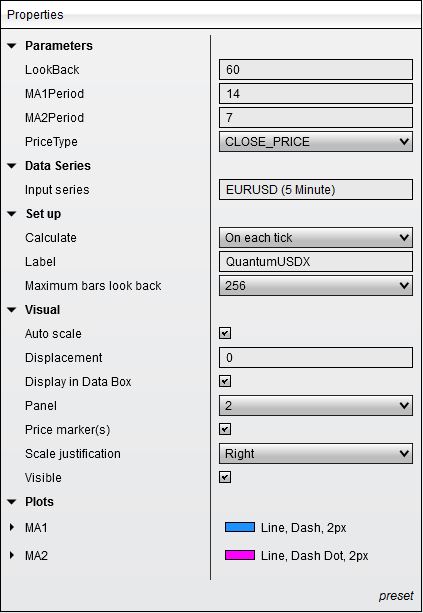
Parameters
LookBack – This parameter determines the number of bars the indicator displays, also as a way of conserving resources for slower machines.
MAPeriod1 – This is the period or length of one of the 2 guiding simple moving averages running across the USDX. It is set to 14 by default and color blue. Though this is the slower moving average of the two, you are free to set this to any timeframe of your choice to suit your personal preferences.
MAPeriod2 – This is the period or length of one of the 2 guiding simple moving averages running across the USDX. It is set to 7 by default and is initially color magenta. Though this is the faster moving average, again you are free to set this to any timeframe of your choice.
PriceType – This is the price type from which the 2 guiding moving averages are calculated. You can either choose OPEN_PRICE, HIGH_PRICE, LOW_PRICE, or CLOSE_PRICE. By default it is set to CLOSE_PRICE.
Data Series
Input series – This shows the timeframe for the indicator and will be displayed according to the chart time.
Set up
Calculate – Please do not change this setting and leave as the default of On each tick.
Label – This is the label which will display on the chart once the indicator is attached.
Maximum bars look back – This is the maximum number of bars in the look back for the indicator. We suggest you leave this as the default of 256 as it is memory friendly.
Visual
Auto Scale – Do not change this setting and leave this as the default of True (checked).
Displacement – Do not change this setting and leave this at the default of 0.
Display in Data Box – We suggest you leave this at the default of True (checked).
Panel – this specifies the panel number where the indicator will appear. We suggest you leave this as the default of 2
Price Marker(s) – Please do not alter this setting and leave as the default of True (checked).
Scale Justification – Please do not alter this setting and leave as the default of Right.
Visible – this shows or hides the plots of the indicator. Please leave it checked to make the indicator visible.
Plots
This is where you can change various properties of the indicator’s plots:
- MA1 – the plot for the first moving average
- MA2 – the plot for the second moving average
A list of plot styles or properties will be shown to you by clicking the arrow graphic beside the plot for you customize the appearance of the plot to your liking:
- Color – the default for MA1 is DodgerBlue while the default for MA2 is Magenta
- Dash style – the default for MA1 is Dash while the default for MA2 is Dash Dot
- Plot style – the default for both plots is Line
- Width – the default for both plots is 2
Once you have made any changes to the settings for the USDX indicator, left click the OK button to complete and update the indicator.
Resizing the indicator
When you first apply the Quantum USDX indicator to the chart the indicator window may need resizing, and below is an example of how the indicator may look with no option changes applied and the default white background of a NinjaTrader chart.
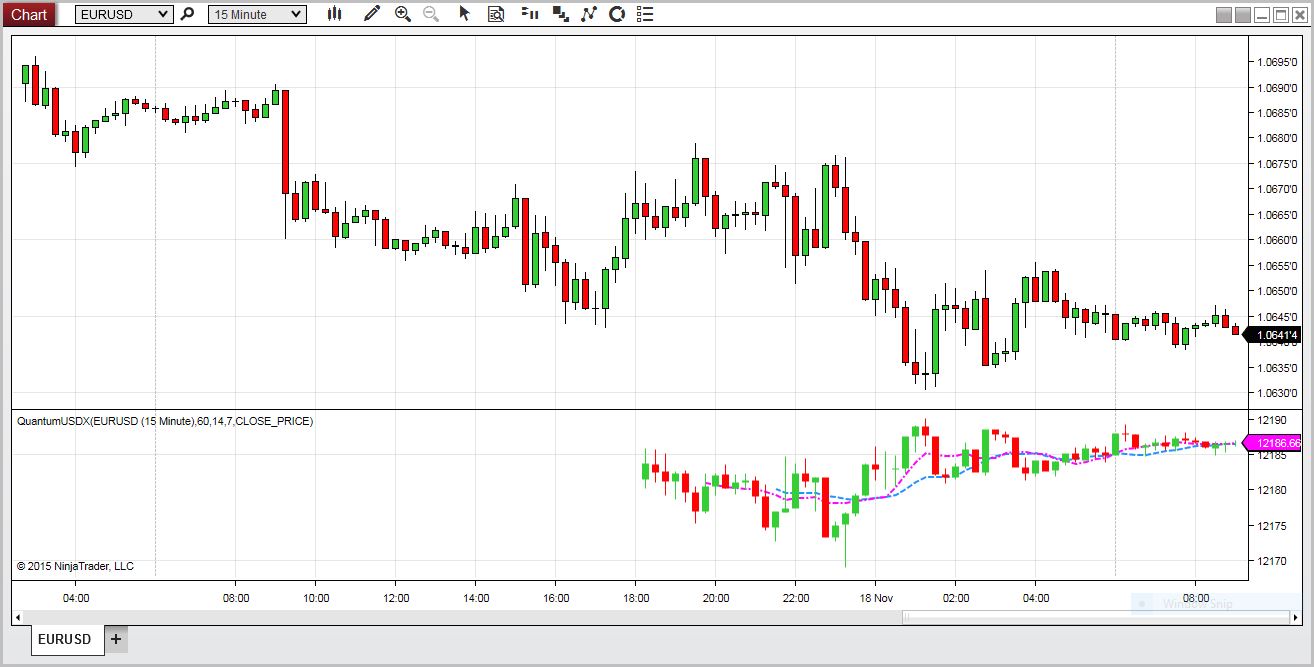
In order to resize the indicator to the maximum height, hover over the horizontal line which separates the chart from the indicator, and you will see a small icon displayed of a solid black line with an arrow above and below. Once this appears, then left click HOLD and drag to resize the indicator window. Your Quantum USDX indicator will then look like this:
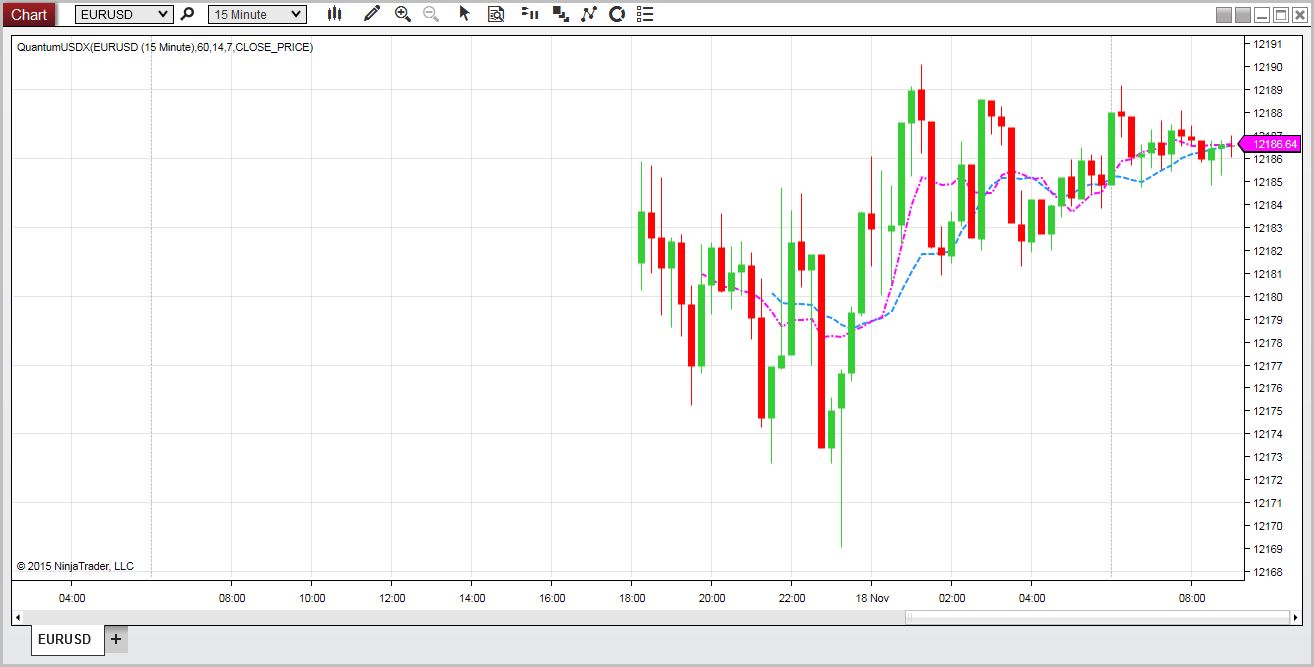
Removing an indicator
These are the steps to remove an indicator from a chart.
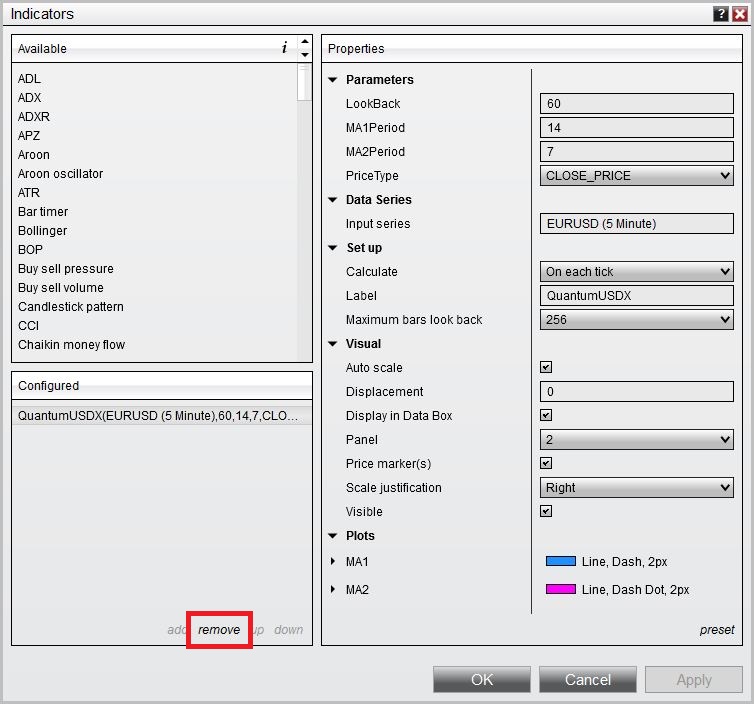
Right click on the chart then select Indicators from the menu. Select QuantumUSDX from the Configured frame and click remove. Click OK to confirm and the indicator should be unloaded from your chart.



